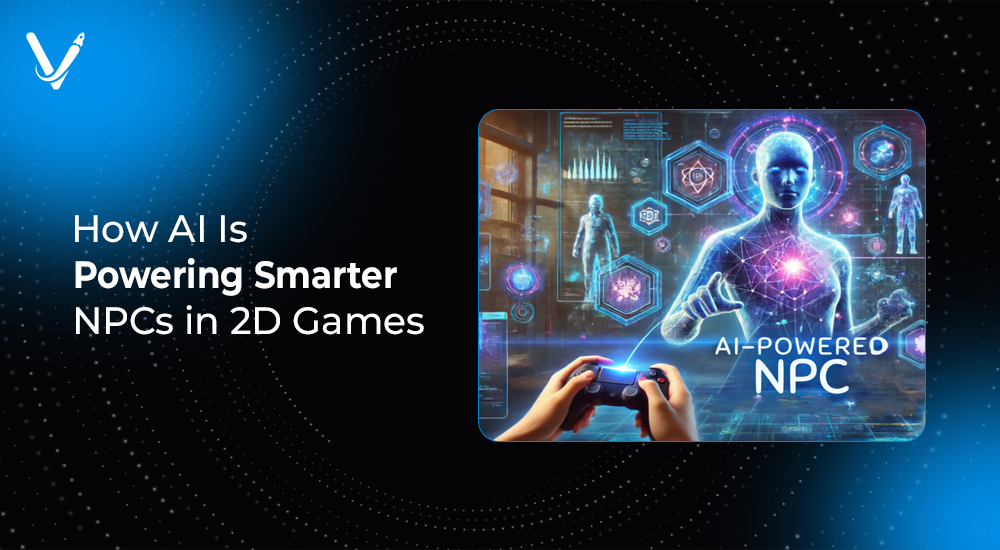How AI Is Powering Smarter NPCs in 2D Games


- Jun 5, 2025
2D games have long held a cherished place in the gaming community. Their simplicity, charm, and nostalgic value continue to appeal to gamers across generations. But in today’s fast-evolving digital landscape, expectations are higher than ever. Gamers now crave more than colorful sprites and catchy soundtracks — they want engaging gameplay, intelligent interactions, and dynamic characters. That’s where AI-powered NPCs in 2D games come into play.
Artificial Intelligence has transcended its role as a backend tool for data analysis and recommendation engines. In the world of game development, AI is revolutionizing how non-player characters behave, respond, and evolve. These smarter NPCs are transforming static environments into living worlds, delivering deeply immersive experiences even within the pixelated realms of 2D games.
This article explores how a game development company leveraging AI in game development is empowering 2D developers to craft smarter non-player characters (NPCs), the core techniques used, benefits delivered, real-world examples, and what the future holds. Whether you're a game designer, indie developer, or curious gamer, this deep dive will illuminate the exciting convergence of AI and 2D gaming.
Non-player characters, or NPCs, are game entities not controlled by the player. They can be allies, enemies, shopkeepers, quest-givers, or simply part of the environment. While they might not always be in the spotlight, NPCs serve crucial functions:
In traditional 2D games, NPCs were largely static or scripted, following predefined paths or repeating dialogues. But modern players want characters that think, react, and surprise, not just stand around.
Traditional NPCs in 2D games follow hardcoded behavior. For instance, a guard may always walk the same path and respond the same way regardless of player actions. This predictability reduces replayability and immersion.
In contrast, AI NPCs can:
This shift enables richer storytelling and gameplay, where NPCs are no longer set pieces but living agents within the game.
FSMs remain a staple in 2D games. An NPC may exist in states like Patrol, Chase, Attack, or Idle, and transition between them based on triggers. While FSMs are deterministic, they form the foundation for more complex behaviors.
Example: In a stealth-based 2D game, a guard NPC uses FSM to patrol, then chases if it spots the player, and returns to idle if it loses sight.
Behavior trees provide a hierarchical model for NPC decision-making. They allow for more modular, scalable, and readable logic compared to FSMs.
Key Benefits:
Navigating 2D worlds realistically requires efficient pathfinding. Algorithms like A* (A-star) and Dijkstra help NPCs move around obstacles intelligently.
In Practice: An enemy NPC in a dungeon game uses A* to find the shortest path to the player while avoiding traps.
Machine learning allows NPCs to learn from player behavior, improving dynamically without explicit programming. While still experimental in 2D games, its potential is enormous.
Real Example: Indie titles are experimenting with reinforcement learning to help boss characters adjust tactics mid-battle based on how players perform.
With NLP, NPCs can hold conversations beyond fixed dialogues. While more common in RPGs, it's starting to appear in 2D indie games via AI-powered chatbot integrations.
AI-powered NPCs breathe life into flat pixel worlds, making every encounter feel meaningful. They observe, react, and even surprise the player — mimicking a living ecosystem.
Games that feature adaptive challenges and evolving NPC interactions encourage replayability and longer player engagement.
AI allows for personalized gameplay, where NPCs remember player choices, evolve relationships, and tailor interactions accordingly.
Developers no longer need to script every line or condition. AI can generate context-aware responses and behaviors dynamically.
Although not heavy on narrative NPCs, the enemies in Dead Cells show reactive behavior patterns. They adapt to player positions, evade attacks, and respond to tactics, adding challenge and excitement.
While not using advanced AI, Undertale features NPCs with memory-like systems. Characters remember your choices, and the story adjusts based on morality — a precursor to true AI NPC behavior.
This 2D roguelike deck-building RPG incorporates adaptive dialogue and decision-making. Characters respond differently based on negotiation tactics and past interactions, hinting at a deeper AI layer beneath.
Though more complex and bordering on 2.5D, it features procedural storytelling where NPC factions, alliances, and relationships shift dynamically, offering emergent narratives each playthrough.
Tools like TensorFlow, PyTorch, and Unity ML-Agents can be integrated with popular 2D engines such as Godot, Unity (2D), or Phaser.
Hybrid models that use traditional logic for structure and machine learning for adaptability provide the best of both worlds.
Even without deep ML knowledge, developers can integrate language models via APIs (e.g., OpenAI) to provide natural conversation systems.
Example: An NPC shopkeeper that adjusts prices based on the player's behavior and can chat using a simplified chatbot.
AI logic should be designed with 2D constraints in mind — memory and CPU usage must be minimal for smooth gameplay across platforms.
Indie devs may lack the compute power or time to train models. Prefabricated AI behaviors or cloud-based solutions can help.
Overly smart NPCs may outmatch casual players or feel unnatural. Tuning AI difficulty and predictability is essential.
Dynamic NPCs must still serve the story. Designers need to ensure AI behavior doesn't break lore or introduce plot holes.
Next-gen AI will simulate emotional states — sadness, anger, trust — affecting dialogue and decisions.
Using language models, developers can create branching dialogues on the fly, resulting in unique conversations each playthrough.
NPCs will function as agents with goals, needs, and social behaviors, creating emergent storylines like simulated villages or criminal syndicates.
AI voice synthesis will allow NPCs in 2D games to speak in real-time, adding another layer of immersion, especially in visual novels and interactive stories.
The integration of AI into 2D game development is no longer science fiction — it's an evolving reality that’s reshaping how games are built, played, and remembered. By infusing smarter NPCs into traditional 2D worlds, developers can deliver deeper engagement, meaningful player choices, and unforgettable adventures.
At Vasundhara Infotech, we specialize in building intelligent, immersive 2D game experiences powered by the latest AI innovations. Whether you're crafting a pixel-art platformer, a roguelike dungeon crawler, or a narrative-rich RPG, our team helps bring your NPCs to life with behavior that players will talk about long after the game ends.
Ready to build the future of 2D gaming?
Reach out to us today and let's create smarter NPCs, together.
Copyright © 2025 Vasundhara Infotech. All Rights Reserved.
